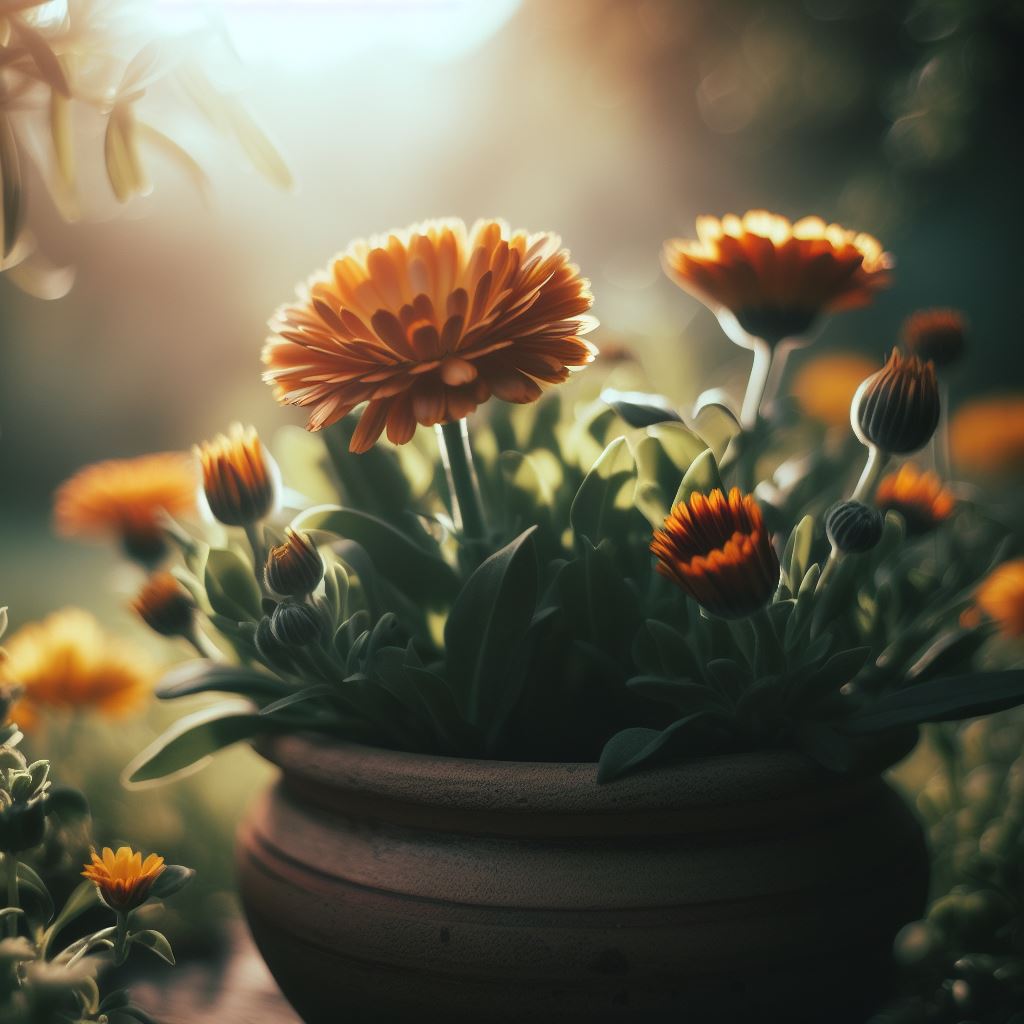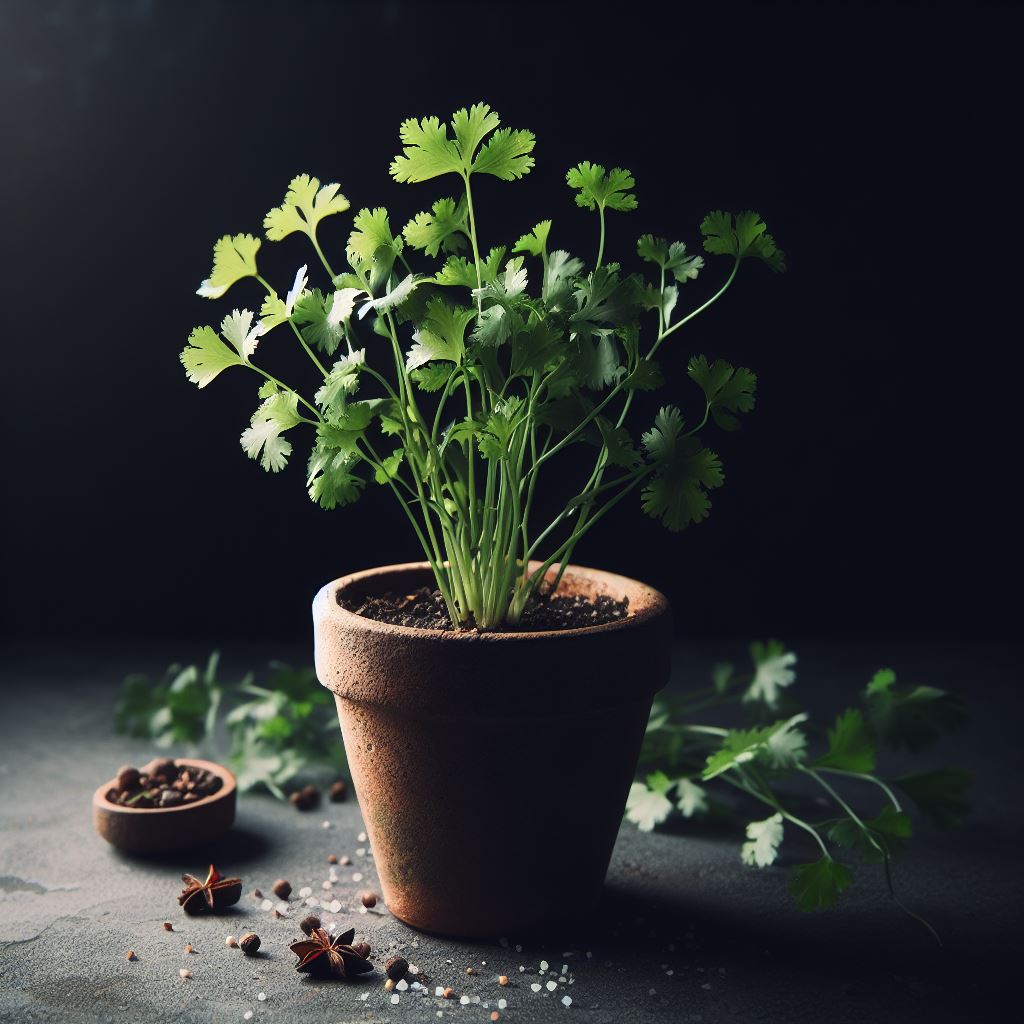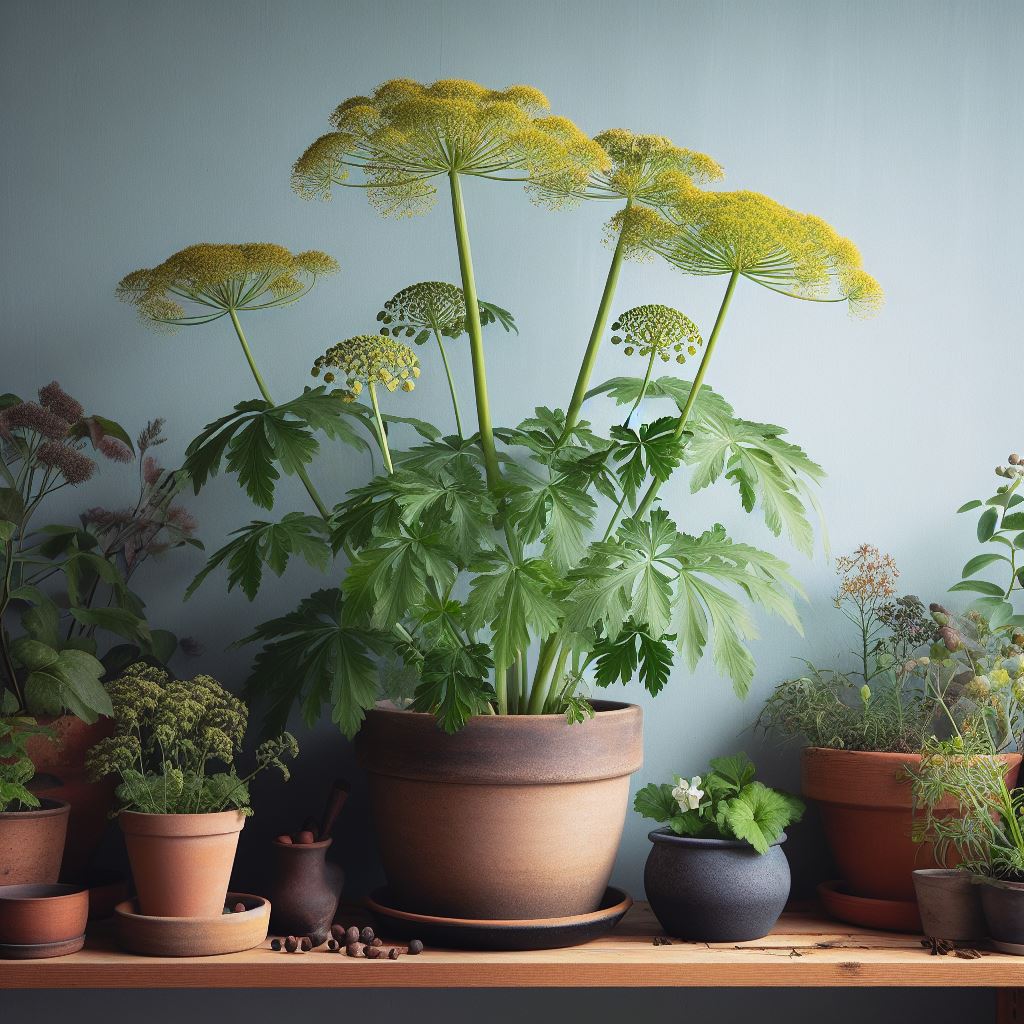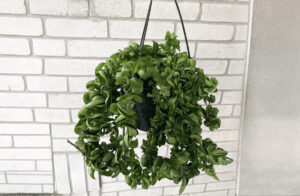
Growing herbs in partial shade outdoors can be a challenge, but it’s also an opportunity to create a beautiful and productive herb garden that can provide fresh ingredients and health benefits. In this article, we’ll explore 13 culinary herbs and 5 medicinal herbs that can thrive in partial shade, as well as tips on how to design and maintain a shade herb garden.
In this article
Key Takeaways
- Partial shade means that the area receives 2-4 hours of sun or filtered light per day
- Some herbs can grow well in partial shade because they are native to woodland habitats or have adapted to low-light conditions
- Growing herbs in partial shade can help them avoid scorching, bolting, or drying out in hot weather, as well as extend their growing season in cold weather
- Some of the benefits of growing herbs in partial shade are adding flavor, fragrance, beauty, and medicinal value to your garden
- Some of the culinary herbs that grow well in partial shade are bee balm, chives, calendula, cilantro, lemon balm, mint, oregano, parsley, rosemary, sage, tarragon, thyme, and wild garlic
- Some of the medicinal herbs that grow well in partial shade are angelica, chamomile, ginseng, nettle, and valerian
- To design a shade herb garden, you need to consider the location, soil type, light and moisture levels, plant arrangement, and maintenance of your plants
13 Culinary Herbs That Grow in Partial Shade
Culinary herbs are plants that are used for their edible parts, such as leaves, flowers, seeds, roots, or stems. They are usually added to dishes to enhance their flavor, aroma, color, or texture. Culinary herbs can also have nutritional and medicinal properties that can benefit your health.
Here are 13 culinary herbs that you can grow in partial shade:
Bee Balm (Monarda didyma)

Bee balm is a perennial herb that belongs to the mint family. It has aromatic leaves and showy flowers that range from pink to red to purple. Bee balm is also known as bergamot or Oswego tea.
Bee balm is used for its leaves and flowers that have a citrusy flavor and scent. You can use them fresh or dried to make tea, salads, sauces, jams, or desserts. Bee balm is also attractive to bees, butterflies, and hummingbirds.
Bee balm grows best in moist and well-drained soil with a pH of 6.0-7.0. It prefers partial shade to full sun and can tolerate some drought. You can propagate it by seeds or division. You can harvest the leaves anytime and the flowers when they are fully open. You can store them in an airtight container or freeze them for later use.
| Common name | Botanical name | Description | Uses | Growing conditions | Harvesting and storage |
|---|---|---|---|---|---|
| Bee balm | Monarda didyma | A perennial herb with aromatic leaves and showy flowers | Tea, salads, sauces, jams, desserts | Moist and well-drained soil with a pH of 6.0-7.0; partial shade to full sun; drought tolerant | Leaves anytime; flowers when fully open; store in an airtight container or freeze |
Chives (Allium schoenoprasum)

Chives are perennial herbs that belong to the onion family. They have thin green stems and purple flowers that form round clusters. Chives are also known as cives or scallions.
Chives are used for their stems and flowers that have a mild onion flavor and aroma. You can use them fresh or dried to garnish soups, salads, omelets, cheese, potatoes, or other dishes. Chives are also rich in vitamin C, folate, and antioxidants.
Chives grow best in fertile and well-drained soil with a pH of 6.0-7.0. They prefer partial shade to full sun and can tolerate some frost. You can propagate them by seeds, division, or cuttings. You can harvest the stems anytime and the flowers when they are fully open. You can store them in a plastic bag in the refrigerator or freeze them for later use.
| Common name | Botanical name | Description | Uses | Growing conditions | Harvesting and storage |
|---|---|---|---|---|---|
| Chives | Allium schoenoprasum | A perennial herb with thin green stems and purple flowers | Garnish soups, salads, omelets, cheese, potatoes, or other dishes | Fertile and well-drained soil with a pH of 6.0-7.0; partial shade to full sun; frost tolerant | Stems anytime; flowers when fully open; store in a plastic bag in the refrigerator or freeze |
Calendula (Calendula officinalis)

Calendula is an annual herb that belongs to the aster family. It has bright yellow or orange flowers that resemble daisies. Calendula is also known as pot marigold or English marigold.
Calendula is used for its petals and leaves that have a spicy and bitter flavor and a pleasant scent. You can use them fresh or dried to make tea, salads, soups, stews, rice, or bread. Calendula is also known for its anti-inflammatory, antiseptic, and healing properties that can help treat skin problems, wounds, infections, or inflammation.
Calendula grows best in rich and well-drained soil with a pH of 5.5-7.0. It prefers partial shade to full sun and can tolerate some frost. You can propagate it by seeds or cuttings. You can harvest the petals and leaves anytime and the flowers when they are fully open. You can store them in an airtight container or freeze them for later use.
| Common name | Botanical name | Description | Uses | Growing conditions | Harvesting and storage |
|---|---|---|---|---|---|
| Calendula | Calendula officinalis | An annual herb with bright yellow or orange flowers that resemble daisies | Tea, salads, soups, stews, rice, bread; skin problems, wounds, infections, inflammation | Rich and well-drained soil with a pH of 5.5-7.0; partial shade to full sun; frost tolerant | Petals and leaves anytime; flowers when fully open; store in an airtight container or freeze |
Cilantro (Coriandrum sativum)

Cilantro is an annual herb that belongs to the parsley family. It has green leaves and white flowers that produce round seeds. Cilantro is also known as coriander or Chinese parsley.
Cilantro is used for its leaves and seeds that have a citrusy and nutty flavor and aroma. You can use them fresh or dried to make salsa, guacamole, curry, soup, salad, rice, or meat dishes. Cilantro is also rich in vitamin A, vitamin C, vitamin K, and iron.
Cilantro grows best in moist and well-drained soil with a pH of 6.0-7.0. It prefers partial shade to full sun and can tolerate some frost. You can propagate it by seeds or cuttings. You can harvest the leaves anytime and the seeds when they are brown and dry. You can store them in a plastic bag in the refrigerator or freeze them for later use.
| Common name | Botanical name | Description | Uses | Growing conditions | Harvesting and storage |
|---|---|---|---|---|---|
| Cilantro | Coriandrum sativum | An annual herb with green leaves and white flowers that produce round seeds | Salsa, guacamole, curry, soup, salad, rice, meat dishes; vitamin A, vitamin C, vitamin K, iron | Moist and well-drained soil with a pH of 6.0-7.0; partial shade to full sun; frost tolerant | Leaves anytime; seeds when brown and dry; store in a plastic bag in the refrigerator or freeze |
Lemon Balm (Melissa officinalis)

Lemon balm is a perennial herb that belongs to the mint family. It has green leaves and white flowers that have a lemony flavor and scent. Lemon balm is also known as balm mint or melissa.
Lemon balm is used for its leaves and flowers that have a calming and uplifting effect on the mood and the nervous system. You can use them fresh or dried to make tea, lemonade, salads, sauces, or desserts. Lemon balm is also known for its antiviral, antibacterial, and antioxidant properties that can help treat cold sores, infections, or inflammation.
Lemon balm grows best in fertile and well-drained soil with a pH of 6.0-7.5. It prefers partial shade to full sun and can tolerate some drought. You can propagate it by seeds, division, or cuttings. You can harvest the leaves anytime and the flowers when they are fully open. You can store them in an airtight containers.
5 Medicinal Herbs That Grow in Partial Shade
Medicinal herbs are plants that are used for their therapeutic effects on the body and mind. They are usually prepared as teas, tinctures, oils, salves, or capsules. Medicinal herbs can also have nutritional and culinary benefits that can support your health.
Here are 5 medicinal herbs that you can grow in partial shade:
Angelica (Angelica archangelica)

Angelica is a biennial or perennial herb that belongs to the parsley family. It has large green leaves and white or yellow flowers that form umbrella-shaped clusters. Angelica is also known as archangel or wild celery.
Angelica is used for its roots, stems, leaves, and seeds that have a sweet and spicy flavor and aroma. You can use them fresh or dried to make tea, cordials, liqueurs, candies, or jams. Angelica is also known for its antispasmodic, expectorant, diuretic, and anti-inflammatory properties that can help treat coughs, colds, bronchitis, asthma, indigestion, bloating, urinary tract infections, or arthritis.
Angelica grows best in rich and moist soil with a pH of 6.0-7.0. It prefers partial shade to full sun and can tolerate some frost. You can propagate it by seeds or division. You can harvest the roots in the fall of the first or second year and the stems, leaves, and seeds in the summer of the second year. You can store them in an airtight container or freeze them for later use.
| Common name | Botanical name | Description | Uses | Growing conditions | Harvesting and storage |
|---|---|---|---|---|---|
| Angelica | Angelica archangelica | A biennial or perennial herb with large green leaves and white or yellow flowers that form umbrella-shaped clusters | Tea, cordials, liqueurs, candies, jams; coughs, colds, bronchitis, asthma, indigestion, bloating, urinary tract infections, arthritis | Rich and moist soil with a pH of 6.0-7.0; partial shade to full sun; frost tolerant | Roots in the fall of the first or second year; stems, leaves, and seeds in the summer of the second year; store in an airtight container or freeze |
Chamomile (Matricaria chamomilla)

Chamomile is an annual herb that belongs to the aster family. It has feathery green leaves and white flowers with yellow centers that resemble daisies. Chamomile is also known as German chamomile or wild chamomile.
Chamomile is used for its flowers that have a sweet and fruity flavor and scent. You can use them fresh or dried to make tea, bath, salve, or oil. Chamomile is also known for its calming, antiseptic, anti-inflammatory, and antispasmodic properties that can help treat insomnia, anxiety, stress, headaches, skin problems, wounds, infections, or menstrual cramps.
Chamomile grows best in sandy and well-drained soil with a pH of 5.5-7.0. It prefers partial shade to full sun and can tolerate some drought. You can propagate it by seeds or cuttings. You can harvest the flowers when they are fully open. You can store them in an airtight container or freeze them for later use.
| Common name | Botanical name | Description | Uses | Growing conditions | Harvesting and storage |
|---|---|---|---|---|---|
| Chamomile | Matricaria chamomilla | An annual herb with feathery green leaves and white flowers with yellow centers that resemble daisies | Tea, bath, salve, oil; insomnia, anxiety, stress, headaches, skin problems, wounds, infections, menstrual cramps | Sandy and well-drained soil with a pH of 5.5-7.0; partial shade to full sun; drought tolerant | Flowers when fully open; store in an airtight container or freeze |
Ginseng (Panax ginseng)

Ginseng is a perennial herb that belongs to the ivy family. It has green leaves and red berries that grow on a fleshy root. Ginseng is also known as Asian ginseng or Korean ginseng.
Ginseng is used for its root that has a bitter and earthy flavor and aroma. You can use it fresh or dried to make tea, extract, powder, or capsule. Ginseng is also known for its adaptogenic, stimulant, antioxidant, and immune-boosting properties that can help treat fatigue, stress, depression, memory loss, diabetes, high blood pressure, or sexual dysfunction.
Ginseng grows best in rich and moist soil with a pH of 5.0-6.0. It prefers partial shade to full shade and can tolerate some frost. You can propagate it by seeds or division. You can harvest the root after 4-6 years of growth. You can store it in a cool and dry place or freeze it for later use.
| Common name | Botanical name | Description | Uses | Growing conditions | Harvesting and storage |
|---|---|---|---|---|---|
| Ginseng | Panax ginseng | A perennial herb with green leaves and red berries that grow on a fleshy root | Tea, extract, powder, capsule; fatigue, stress, depression, memory loss, diabetes, high blood pressure, sexual dysfunction | Rich and moist soil with a pH of 5.0-6.0; partial shade to full shade; frost tolerant | Root after 4-6 years of growth; store in a cool and dry place or freeze |
Nettle (Urtica dioica)

Nettle is a perennial herb that belongs to the nettle family. It has green leaves and greenish flowers that are covered with stinging hairs. Nettle is also known as stinging nettle or common nettle.
Nettle is used for its leaves and roots that have a mild and nutty flavor and aroma. You can use them fresh or dried to make tea, soup, salad, pesto, or juice. Nettle is also known for its anti-inflammatory, antihistamine, diuretic, and tonic properties that can help treat allergies, arthritis, anemia, urinary tract infections, or kidney stones.
Nettle grows best in fertile and moist soil with a pH of 6.0-7.0. It prefers partial shade to full sun and can tolerate some frost. You can propagate it by seeds or division. You can harvest the leaves before flowering and the roots in the fall. You can store them in an airtight container or freeze them for later use.
| Common name | Botanical name | Description | Uses | Growing conditions | Harvesting and storage |
|---|---|---|---|---|---|
| Nettle | Urtica dioica | A perennial herb with green leaves and greenish flowers that are covered with stinging hairs | Tea, soup, salad, pesto, juice; allergies, arthritis, anemia, urinary tract infections, kidney stones | Fertile and moist soil with a pH of 6.0-7.0; partial shade to full sun; frost tolerant | Leaves before flowering; roots in the fall; store in an airtight container or freeze |
Valerian (Valeriana officinalis)

Valerian is a perennial herb that belongs to the honeysuckle family. It has green leaves and pink or white flowers that have a strong and unpleasant odor. Valerian is also known as garden heliotrope or all-heal.
Valerian is used for its roots that have a sweet and earthy flavor and aroma. You can use them fresh or dried to make tea, tincture, oil, or capsule. Valerian is also known for its sedative, antispasmodic, and analgesic properties that can help treat insomnia, anxiety, nervousness, muscle cramps, headaches, or menstrual pain.
Valerian grows best in rich and moist soil with a pH of 5.5-7.0. It prefers partial shade to full sun and can tolerate some drought. You can propagate it by seeds or division. You can harvest the roots in the fall of the second or third year of growth. You can store them in an airtight container or freeze them for later use.
| Common name | Botanical name | Description | Uses | Growing conditions | Harvesting and storage |
|---|---|---|---|---|---|
| Valerian | Valeriana officinalis | A perennial herb with green leaves and pink or white flowers that have a strong and unpleasant odor | Tea, tincture, oil, capsule; insomnia, anxiety, nervousness, muscle cramps, headaches, menstrual pain | Rich and moist soil with a pH of 5.5-7.0; partial shade to full sun; drought tolerant | Roots in the fall of the second or third year of growth; store in an airtight container or freeze |
How to Design a Shade Herb Garden
Creating a shade herb garden can be a rewarding and enjoyable experience that can enhance your garden’s beauty and productivity. Here are some general tips on how to plan and create a shade herb garden:
- Choose a suitable location and soil type: The ideal location for a shade herb garden is one that receives at least 2-4 hours of sun or filtered light per day. You can also use artificial lighting such as grow lights or lamps to supplement the natural light. The ideal soil type for a shade herb garden is one that is rich, well-drained, and slightly acidic. You can also add mulch, compost, and organic fertilizer to improve the soil quality and moisture retention.
- Consider the light and moisture levels of different herbs: Different herbs have different preferences and tolerances for light and moisture levels. You can group the herbs according to their needs and arrange them accordingly. For example, you can place the herbs that need more sun and less water near the edge of the shade area, and the herbs that need less sun and more water near the center of the shade area.
- Arrange the plants according to their height, spread, and color: You can create a visually appealing and harmonious shade herb garden by arranging the plants according to their height, spread, and color. You can place the taller and bushier herbs at the back or in the middle of the garden, and the shorter and smaller herbs at the front or around the edges of the garden. You can also mix and match the colors of the herbs to create contrast and interest.
- Add some decorative elements: You can also add some decorative elements to your shade herb garden to make it more attractive and inviting. You can use pots, containers, baskets, trellises, stakes, or markers to display your herbs. You can also use stones, bricks, tiles, or wood to create paths, borders, or edging for your garden. You can also use statues, sculptures, fountains, or bird baths to add some charm and character to your garden.
- Prune, water, and weed regularly: To maintain the health and appearance of your shade herb garden, you need to prune, water, and weed regularly. You can prune your herbs to remove any dead, diseased, or damaged parts, as well as to shape them and encourage new growth. You can water your herbs according to their needs, but avoid overwatering or underwatering them. You can weed your garden to remove any unwanted plants that may compete with your herbs for space, nutrients, or light.
Growing herbs in partial shade is not only possible, but also rewarding and enjoyable. You can grow a variety of herbs that can add flavor, fragrance, beauty, and medicinal value to your garden. You can also design and maintain a shade herb garden that can enhance your garden’s beauty and productivity. Whether you have a small balcony, a shady corner, or a woodland area, you can grow herbs in partial shade that will suit your needs and preferences.
Happy gardening!
Frequently Asked Questions
What is the difference between partial sun and partial shade?
Partial sun means that the area receives 3-6 hours of direct sun per day, while partial shade means that the area receives 2-4 hours of sun or filtered light per day.
What are some signs that my herbs are getting too much or too little light?
Some signs that your herbs are getting too much light are wilting, yellowing, scorching, or drying out of the leaves. Some signs that your herbs are getting too little light are leggy, weak, pale, or sparse growth.
How can I increase the light in my shade herb garden?
ou can increase the light in your shade herb garden by trimming or removing any overhanging branches or structures that block the sun, using reflective materials such as white paint or mirrors to bounce the light around, or adding artificial lighting such as grow lights or lamps.
I hope you enjoyed this article on how to grow herbs in partial shade. If you want to learn more about growing herbs indoors, you can check out this article on Which Indoor Herbs Thrive in Partial Shade?. You can also watch these YouTube videos for more tips and ideas:







